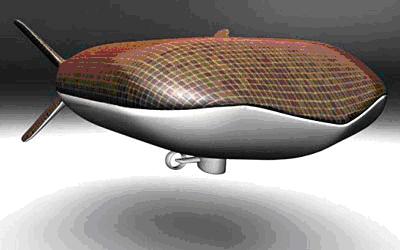Airships hovering on the edge of space could turn an entire city into one big wireless hotspot. Will they take off?
Popular Sciences

Direct link to this page: https://www.hayadan.org.il/pashalal0505.html
At the end of winter, an unnamed company called Sanswire Networks will launch a prototype of a 27-meter-long communications spaceship from Edwards Air Force Base, near Los Angeles, into the stratosphere - at an altitude of over 15 km - as part of a first-of-its-kind operation.
If the launch of the prototype is crowned a success, the company intends to produce a commercial version by the end of the year, in the area of a football field and the height of a nine-story building. The spaceship that will be filled with helium (stratellite) will hover at a height of nearly 20 km above the surface of the earth, for two years at a time, and will give subscribers within a range of up to 650 km access to high-speed Internet and telephone services - says Timothy Huff, CEO of GlobeTel Communications, Sanswire's parent company.
The very idea of a spaceship for communication purposes is not new. Several companies, including 21st Century Airships and Worldwide Aeros, as well as the US military, are racing to realize it. Such a spacecraft hovers lower than satellites, and it can transmit signals in its field of view directly to an antenna that will be installed in the subscriber's home or business - without the need for cellular antenna towers or expensive cable infrastructure. The consumer will enjoy better coverage than Wi-Fi wireless points (no dead zones), and a faster Internet service that costs less than cable or DSL. Unlike a satellite, an airship can be reused and is also relatively cheap. Huff estimates that the ship will cost $5 million to $10 million - less than a tenth of the price of most satellites.
Still, the technical problems are many, and the industry doubts Sanswire's ability to solve them. "I estimate the chance of a new, unknown company suddenly producing a spaceship as one in a million," says Hawken Kolting, CEO of 21st Century Airships, which plans to launch its own prototype in 2006. One of the main problems is the power source. The spaceship must be light enough to be able to float in the stratosphere, and strong enough to operate equipment weighing thousands of kilograms for many months without refueling. The solution that Sanswire found is a huge layer of solar collectors that, according to her, produce 400,000 kWh per hour - enough electricity to power 200 homes. At night, the light of the moon and the stars is used.
However, not everyone is convinced: according to Colin Marchi, spokesman for the Solar Energy Industry Association, "it is not possible to extract a useful amount of energy from starlight." -Mike Payden
Sale for users of the Hidan website - a 3-month subscription to Popular Science for NIS 49
https://www.hayadan.org.il/BuildaGate4/general2/data_card.php?Cat=~~~155831209~~~64&SiteName=hayadan
